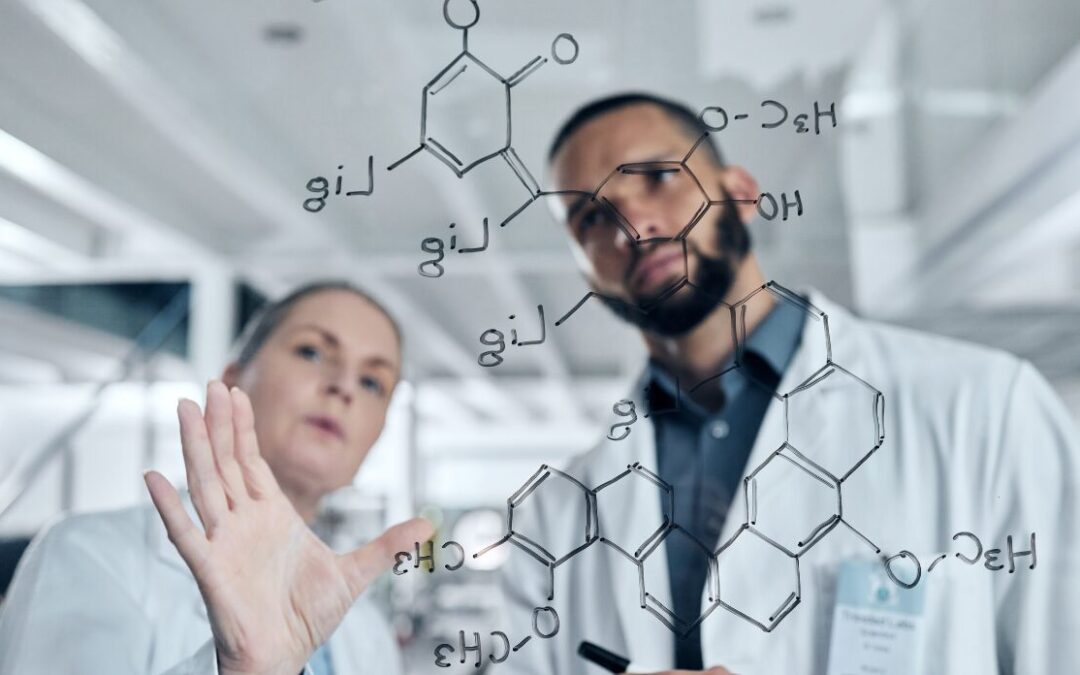In the ever-evolving pharmaceutical research landscape, a new frontier is emerging: Artificial Intelligence (AI) in drug discovery. As with previous technological revolutions, the pharmaceutical industry is at the forefront of adopting this game-changing innovation.
Drug discovery has long been a costly and time-consuming process, often taking over a decade and billions of dollars to bring a single drug to market. However, the integration of advanced machine learning algorithms and AI is poised to dramatically transform this landscape.
Consider the story of Paul, an 82-year-old man battling an aggressive form of blood cancer. After six unsuccessful rounds of chemotherapy, hope seemed lost. Enter AI-driven drug discovery. Through a groundbreaking trial by the Medical University of Vienna and Exscientia, a UK-based AI company, Paul’s cancer met its match. Using AI to analyze tissue samples and predict effective drug combinations, researchers identified a treatment that traditional methods had overlooked. Two years later, Paul was in complete remission.
This success story isn’t just about one life saved; it represents a paradigm shift in drug discovery. AI has the potential to:
- Slash development costs to a fraction of their current levels
- Reduce the time from discovery to approval from 12-15 years to just a few years
- Increase the success rate of drug candidates
But how exactly does AI achieve these remarkable feats? And how are pharmaceutical companies adapting to harness this transformative technology? Let’s delve deeper into the world of AI-powered drug discovery and explore its far-reaching implications for the future of medicine.
Where Traditional Drug Discovery Processes Fail

Rising costs have cast a long shadow over the traditional drug discovery process followed by pharma companies. Fewer than 14% of drug candidates enter phase 1 clinical trials successfully, securing FDA approval.
As mentioned earlier, the current drug discovery journey typically spans 10-15 years and incurs a staggering investment of $2.5 billion per approved drug. That’s right – $2.5 billion for a single drug.
A couple of contributing factors to these high costs are:
- Our limited comprehension of disease mechanisms
- The inherent inaccuracies of current disease modeling technologies
- The formidable challenge of translating model results into tangible patient outcomes
Furthermore, we must confront the limitations of animal models, which have long been regarded as the gold standard for predicting human responses during drug development. These models often yield inaccurate predictions and raise ethical concerns, especially as our society collectively calls for cruelty-free research and drugs.
So, how can pharma companies fix the above issues?
Even a decade earlier, these issues would have been laughed off as business limitations. But today, these issues are solvable, thanks to the use of machine learning algorithms and advanced AI technologies.
This is vouched for by the observations from the McKinsey Global Institute, which highlight the ongoing AI-driven transformation within the pharmaceutical industry.
The insights note that previously, scientists dedicated a significant portion of their time to manual tasks, such as pipetting and data curation.
However, AI is now poised to automate and expedite these processes.
Fareed Melhem, SVP and Head of Medidata AI, a leader in the application of AI within the drug development industry, had the following to say about AI in drug discovery, “There is a lot that will be transformative about AI and ML in drug development. This is a new way to understand data and gives us a better ability to search for and unlock knowledge from legacy materials.
While automation is certainly not a new technology, its combination with AI makes it a very powerful tool for pharma companies to analyze large amounts of data and gain meaningful insights from it.
This was a very important hurdle for the pharmaceutical industry to overcome, as data management and analysis have been two of the pillars of drug discovery in the industry.
But is AI in drug discovery just limited to data analysis? or is there more than what meets the eye?
How Does AI in Drug Discovery Help the Pharmaceutical Industry?
BenevolentAI’s Bryn Williams-Jones has clearly stated, “There are no shortcuts to drug discovery. We can have better-informed ideas, but you still have to go through the rest of the [development] process.”
So what does AI really offer in the lab?
BCG reports that AI holds three fundamental promises:
Speed, Accuracy, and Cost-effectiveness
By swiftly analyzing vast datasets, AI accelerates the identification of potential drug candidates during the “discovery” stage.
It enhances accuracy by providing deeper insights into molecular interactions, minimizing the risk of late-stage failures. Most notably, AI can reduce drug discovery time and costs by 25 to 50%, reshaping the cost factors in the field.
AI in Drug Discovery Saves Time

AI has the potential to reduce the time required for drug discovery and clinical trials
In a recent study, researchers examined the research pipelines of 20 AI-intensive pharmaceutical companies spanning the years from 2010 to 2021. Utilizing publicly available data, the analysis unveiled a compelling trend: approximately 15 drug candidates had progressed to the clinical trial stage.
Even more striking was the reconstruction of the development timelines of eight of these candidates. Astonishingly, all eight had reached clinical trials within a decade, with five accomplishing this feat in less time than the historical average.
One standout example is Insilico Medicine, a pharmaceutical company jointly headquartered in New York City and Hong Kong. In February, Insilico Medicine announced the initiation of phase I clinical trials for an AI-designed drug candidate targeting idiopathic pulmonary fibrosis.
Remarkably, this drug candidate traversed the entire journey from discovery through preclinical stages in a mere 30 months. Subsequently, phase II trials commenced, delving deeper into the drug’s efficacy and safety – all in a timeline of less than 5 years. An absolutely unheard speed in the field of drug discovery.
Virtual Drug Libraries, Advanced Imaging and the Power of AI
So far, we have stated that AI in drug discovery helps speed up the discovery and preclinical processes. But how exactly does an AI model achieve this?
In recent years, the pharmaceutical industry has embraced computational tools to speed up drug discovery.
This has been driven by abundant data on ligands, protein structures, and virtual libraries with billions of small molecules.
Three techniques are at play here –
- Very-Large-Scale Integration (VLS) technology;
- The Protein Data Bank (PDB), a database for the 3D structural data of large biological molecules
- Advanced imaging

Compared to traditional approaches like High-Throughput Screening (HTS) and fragment-based ligand discovery (FBLD), VLS demonstrates a higher hit rate, which is the total percent of the time where a specific outcome is achieved.
In drug discovery, this translates to a faster identification time for the right drug candidates during trials.
Virtual screening algorithms, reliant on protein and ligand structures, coupled with AI-based models, further accelerate candidate identification. On-demand and generative virtual chemical spaces allow rapid parallel synthesis, fostering the exploration of novel chemical scaffolds.
This computational-driven approach has transformed drug discovery for the better. The combination of advanced computational tools, virtual libraries, and chemical spaces promises to identify potential drug candidates within months – all due to the AI models running them.
Predictive Modeling and Machine Learning Algorithms
Here’s an industry fact – Approximately 90% of clinical trials fail, either due to low efficacy or high toxicity.
However, AI is overcoming that.
AI/ML techniques are becoming instrumental in streamlining drug development by reducing costs and accelerating timelines. All the while, improving the likelihood of success.
In pre-clinical research and development (R&D), natural language processing (NLP) extracts insights from unstructured data sources like biomedical literature and electronic medical records.
Predictive modeling forecasts protein structures and optimizes molecular compounds, aiding in the identification of potential drug candidates with higher success probabilities.
With the exponential growth in complex data from genomics, imaging, and wearable devices, ML methods have proven invaluable in handling the “Large p, Small n” challenge. This is when variables (“p”) are high but samples (“n”) are low in number, an issue that arose in the past due to the lesser availability of high quality data.
AI-driven approaches also extend to post-marketing research. This is done by enhancing the understanding of a drug’s benefit-risk profile, identifying treatment sequences, and pinpointing patient subgroups that benefit most from specific treatments, enabling precision medicine.
AlphaFold, an AI network developed by Google’s DeepMind, predicts protein structures with remarkable accuracy, significantly benefiting drug discovery and understanding protein-folding diseases like Alzheimer’s and Parkinson’s.

DeepMind’s AlphaFold is solving decade-long challenges with drug discovery using AI algorithms
Furthermore, AI guides lead optimization by predicting pharmacological properties, reducing animal studies, and designing selective drugs with minimal side effects.
Examples of this include:
- Predicting bioactivity through quantitative structure-activity relationship (QSAR) modeling and molecular docking.
- Deep learning techniques that empower the discovery of new compounds and their optimization for specific targets. This reduces the chances of side effects.
Identifying Disease Targets and Potential Drug Candidates Through AI

Treating and preventing Alzheimer’s is one of the biggest challenges of the decade
Alzheimer’s disease affects 43.8 million people worldwide.
Traditionally, the search for potential drug targets relied on genome-wide association studies (GWAS), but translating these findings into actionable drug candidates presented significant challenges.
That scenario is changing with the introduction of a new network-based AI framework that leverages multi-omics data, protein-protein interactome networks, GWAS insights, and drug-target networks. Which basically means that the AI framework can process various data points and identify solutions that are more likely to succeed.
Applied to Alzheimer’s disease, this innovative approach not only identifies high-confidence Alzheimer’s risk genes (ARGs). But, it also pinpoints druggable targets for therapeutic development.
The implications of these findings are profound. Three specific drugs—pioglitazone, febuxostat, and atenolol—have emerged as promising candidates for mitigating Alzheimer’s disease.
In particular, pioglitazone, an FDA-approved peroxisome proliferator-activated receptor (PPAR) agonist originally designed for type 2 diabetes management, has shown remarkable potential for reducing the risk of Alzheimer’s disease.
All because of AI.
To put this into perspective, a suitable AI framework is able to achieve things that have taken pharma research institutes billions of dollars and decades to find. This is not to say that AI will completely replace human researchers and companies.
On the contrary, the implementation of AI technologies within drug discovery research will actually benefit companies that can design better drugs for cheaper costs in a much quicker timeline.

AI in Drug Discovery is Great, But What About the Regulations?

FDA-approvals take a lot of time. AI-assisted drug discovery can help slash down the timeline and costs
The former MD of PayPal, Peter Thiel, once said, “If you’re trying to develop a new drug, that costs you a billion dollars to get through the FDA. If you want to start a software company, you can get started with maybe $100,000.”
He wasn’t joking. Approving drugs and the entire process around clinical trials after research is an expensive and time-consuming process.
So far, we have understood that AI carries the potential to vastly decrease the time taken to discover new drugs.
But where does the FDA stand on AI intervention in drug discovery?
In June 2023, the FDA released a discussion paper titled “Using Artificial Intelligence and Machine Learning in the Development of Drug and Biological Products.”
This document offers valuable definitions, distinguishing ML as a subset of AI. Moreover, highlighting that ML models are developed through data analysis without explicit programming.
The FDA acknowledges the increasing utilization of AI/ML in drug development. With a notable surge in AI/ML-based submissions, over 100 in 2021, covering drug discovery, clinical research, safety surveillance, and pharmaceutical manufacturing.
AI/ML is also being integrated into areas like Digital Health Technologies (DHTs) and Real-World Data (RWD) analytics. Here the FDA is actively engaged.
So far, the FDA is working on a flexible, risk-based regulatory framework that protects patient data and safety. While also allowing more AI-based innovation for companies.
This means, in a nutshell, the FDA has no significant concerns about the use of AI in drug discovery and development. This is a major win for the pharmaceutical companies looking to use AI in the US.

Implementing AI for Pharma Companies
Let’s summarize what we have covered so far:
- AI works very well for pharma research, and all findings so far support the fact that AI can massively slash down costs and timelines associated with drug discovery and development.
- The combination of data analysis and AI has led to a reduction in manual tasks for researchers, such as data curation and pipetting. This leads to better productivity and efficiency for a research team.
- Powerful technologies such as Very-Large-Scale Integration (VLS) technology, The Protein Data Bank (PDB) and Advanced imaging can be used together within an AI framework to successfully identify right drug candidates in short timelines. This improves the accuracy of finding the right candidates before trials.
- Machine Learning Algorithms and Predictive Modeling are great at forecasting protein structures and post-marketing research to identify the right treatment groups based on the drug’s risk profiles and the patient’s previous medical history.
- The FDA has not listed any concerns with AI-related drug discovery and encourages the use of new technologies as long as existing rules and regulations are followed.
The above pointers all convey the same message: AI is an extremely powerful technology when used effectively. It can save billions of dollars and years of research for pharmaceutical companies.
But getting there requires an actionable plan.
This includes careful research, identifying areas where AI can work, and implementing that AI technology effectively within the organization.
Such a process would include creating an AI-use policy within the organization. Alongside, employee training, AI model configuration, testing and optimization, and finally – scaling the AI model as per business requirements.
This is where pharmaceutical companies are encouraged to work with a trusted AI implementation partner who has the experience and technical knowledge to plan out such a massive endeavour.
Partnering with Kanerika
Kanerika has worked with various healthcare and pharmaceutical companies in the USA. And has helped these organizations implement the latest AI/ML and data management frameworks.
Once implemented, an AI framework can cut costs and improve efficiency throughout the organization. This is especially important for an industry like pharma. Where initial drug discovery and development costs can be a few billion dollars, even before clinical trials.
In our experience, we have helped companies cut down staffing costs by at least 50% after AI implementation. We have also optimized their teams to perform their tasks with up to 90% accuracy.
However, AI has the ability to go beyond just saving costs and improving workforce efficiency. Imagine a future where drugs can be synthesized as per a person’s genome profile. Meanwhile, predictive technologies can alert patients of possible diseases in the future.
Clearly, AI holds great promise for the pharma industry and patients, but the billion-dollar question is; how soon can we implement it?
In my opinion, the time is now.
















